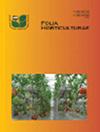Parameters of radish phytomass (Raphanus sativus L.) determined by vermicompost and earthworms (Eisenia fetida)
IF 1.8
4区 农林科学
Q2 HORTICULTURE
引用次数: 2
Abstract
Abstract In 2-year outdoor pots experiment, which was realised in the vegetation cage situated in the campus of Slovak University of Agriculture in Nitra, both the impact of different doses of vermicompost (Vc) (0%, 10%, 20%, 25% and 50%) and the number of earthworms (EW) (0, 10 and 20 individuals/pot) in the soil substrate were studied on the quantitative and qualitative parameters of radish yield. The achieved results show that along with the increasing quantity of Vc, the total chlorophyll content also increased proportionally. The content of vitamin C declined and the content of nitrates increased in both the aboveground and underground biomass. The weight of the roots and leaves of radish increased until the content of Vc in the substrate did not exceed 20%. Vermicompost abundance >20% led to the decline of root and leaf biomass formation. The root yield and leaf biomass were higher in the presence of 50% Vc content in the substrate, compared with the control. The EW had mostly a negative impact on radish phytomass formation, particularly both weight and root diameter. The highest percentage of roots weight decline cultivated in the treatment with EW were obtained with the least dose of Vc (10%), thereby the least quantity of fodder for the EW. The impact of EW on the total chlorophyll, vitamin C and nitrates contents in roots and leaves was non-significant. The number of EW did not influence the root diameter and content of vitamin C; however, it affected the root weight.蚯蚓和蚯蚓测定萝卜(Raphanus sativus L.)植物群参数
摘要在位于尼特拉的斯洛伐克农业大学校园内的植被笼中进行了为期2年的户外盆栽实验,研究了不同剂量的蚯蚓堆肥(Vc)(0%、10%、20%、25%和50%)和土壤基质中蚯蚓数量(0、10和20条/盆)对萝卜产量的定量和定性参数的影响。结果表明,随着Vc用量的增加,总叶绿素含量也呈比例增加。地上和地下生物量中维生素C含量下降,硝酸盐含量增加。萝卜根和叶的重量增加,直到基质中Vc的含量不超过20%。虫体丰度>20%导致根和叶生物量形成下降。与对照相比,基质中Vc含量为50%时,根系产量和叶片生物量较高。EW对萝卜植物团的形成,特别是对根重和根径都有负面影响。在EW处理中培养的根重下降百分比最高的是用最小剂量的Vc(10%),因此EW的饲料量最少。EW对根和叶中总叶绿素、维生素C和硝酸盐含量的影响不显著。EW的数量对根径和维生素C含量没有影响;但对根重有影响。
本文章由计算机程序翻译,如有差异,请以英文原文为准。
求助全文
约1分钟内获得全文
求助全文
来源期刊

Folia Horticulturae
Agricultural and Biological Sciences-Horticulture
CiteScore
3.40
自引率
0.00%
发文量
13
审稿时长
16 weeks
期刊介绍:
Folia Horticulturae is an international, scientific journal published in English. It covers a broad research spectrum of aspects related to horticultural science that are of interest to a wide scientific community and have an impact on progress in both basic and applied research carried out with the use of horticultural crops and their products. The journal’s aim is to disseminate recent findings and serve as a forum for presenting views as well as for discussing important problems and prospects of modern horticulture, particularly in relation to sustainable production of high yield and quality of horticultural products, including their impact on human health.
 求助内容:
求助内容: 应助结果提醒方式:
应助结果提醒方式:


